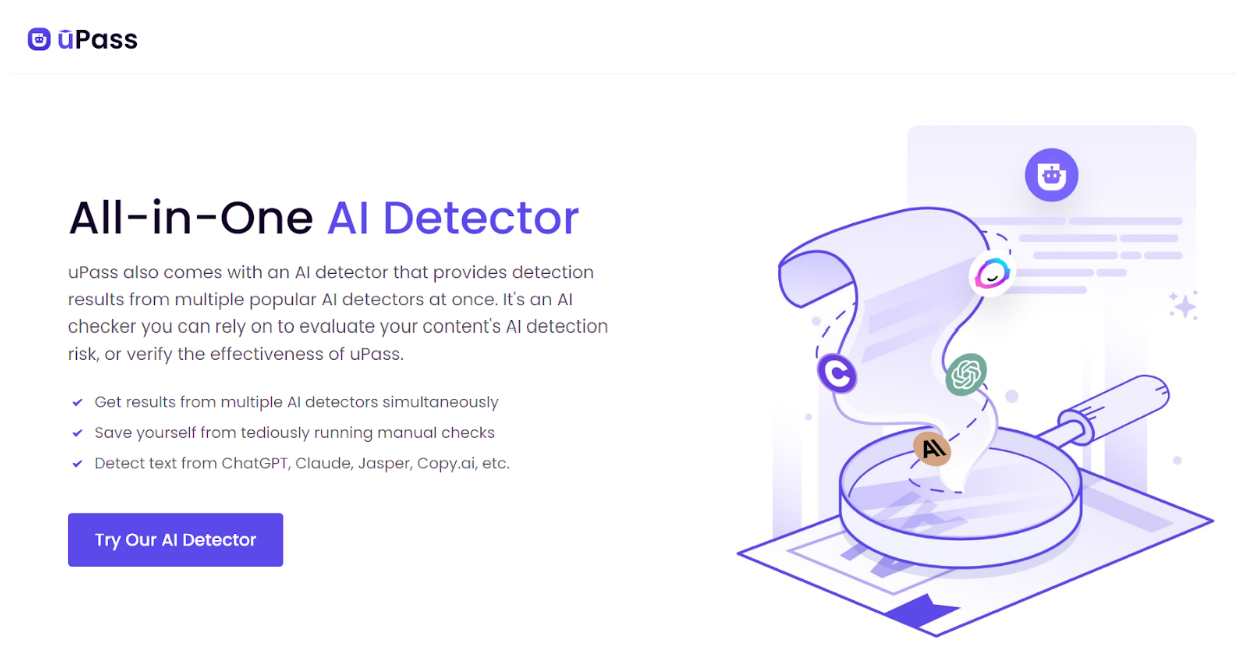Top 10 Solutions to Bypass AI Detection & Humanize Your Assignments
In the evolving landscape of academic writing, Artificial Intelligence (AI) has carved a significant niche, altering how assignments, essays, and papers are crafted. However, with the rise of AI has also come the enhanced ability of institutions to detect AI-generated content, thanks to advanced AI Detectors. This development has catalyzed a need for innovative tools that can bypass AI detection, ensuring content remains undetectable and preserves the essence of academic integrity. Below, we delve into the ten best solutions for students and academicians seeking to navigate this new terrain, with uPass leading the charge.
1. uPass: The Ultimate Undetectable AI Rewriter and AI Detector
uPass stands out as the ultimate tool for bypassing AI detection in academic writing. By seamlessly converting AI-assisted assignments, essays, or papers into undetectable content, uPass ensures that your academic work is safeguarded against the scrutiny of Turnitin and other plagiarism checkers. Far from being a mere paraphraser, uPass is equipped to maintain the original essence of your work while making it appear entirely crafted by a human.
Features That Set uPass Apart:
- Comprehensive AI Detection: It comes equipped with an AI Detector that checks texts against multiple detectors simultaneously.
- Plagiarism-Free Outputs: uPass guarantees outputs free from duplication, an essential feature for academic integrity.
- Broad Application: Whether it's literature, computer science, or philosophy, uPass tailors content across disciplines without losing the original context.

2. AIWriter: A Smart Writing Assistant
AIWriter takes a slightly different approach by offering a writing assistant that generates first drafts based on titles or keywords. While not specifically designed to bypass AI detectors, its output, with subsequent human editing, can effectively blend into human-created content, reducing detectability.
Strengths:
- Speedy Draft Generation: Useful for getting a quick start on any topic.
- Adaptability: With editing, the final output can be made less detectable.

3. Grammarly’s Tone Detector
Though not a rewriting tool, Grammarly’s Tone Detector aids in giving your AI-generated content a human touch, focusing on emotional cues that AI often misses. This subtle refinement can minimize the 'AI feel' of a text, making it more palatable for human readers and possibly less detectable.
Unique Offerings:
- Tone Adjustments: Helps in fine-tuning the emotional depth of your writing.
- Grammar and Style Enhancements: Polishes content to reduce errors that may flag as AI-generated.
4. QuillBot
QuillBot is a paraphrasing tool that comes with a range of writing modes, including one designed to enhance fluency. Though like uPass in intention, it's more of a broad tool than one specifically designed to evade AI detection.
Core Features:
- Versatility in Writing Modes: Useful for adapting content to sound more natural.
- Integration Capacity: Works within your browser for ease of use.
5. Copysmith
Copysmith targets content creators with generation needs but offers features that academic writers can advantageously apply. Its strength lies in generating original content out of simple inputs, which could aid in diminishing AI-detection risks post-refinement.
Key Benefits:
- Content Originality: Aids in producing more unique content outlines.
- Scalability: Efficient for handling significant volumes of content generation.
6. ArticleForge
Using deep learning to produce articles from keywords, ArticleForge is another content creation tool that, with adjustments, can generate assignments or essays. Its focus on producing SEO-friendly content inevitably requires human editing to tweak its outputs for academic purposes.
Advantages:
- Research and Writing: Capable of pulling in relevant content based on keywords.
- Time Efficiency: Reduces the initial time spent on drafting content.
7. Writesonic
Writesonic presents itself as an all-encompassing writing tool, from marketing to article writing. Its academic writing assistant can be a starting point for essays and proposals that still maintains a human-like quality after editing.
Key Features:
- Versatility: Covers a wide array of writing needs.
- AI Article Writer: Specific features catered to more formal writing.
8. Smodin Rewriter
Smodin Rewriter is another tool for rephrasing or rewriting text to improve uniqueness. While its technology may not be as advanced as uPass in avoiding AI detection, it does offer a simple interface for enhancing originality.
Positive Aspects:
- Ease of Use: User-friendly interface for quick rewrites.
- Multiple Languages: Supports rewriting in several languages.
9. Text Blaze
Text Blaze is aimed more at productivity, offering snippets and shortcuts for faster writing. However, its utility in scripting and template creation can assist academic writers in formulating patterns that lessen the ‘AI-generated’ footprint by customizing outputs.
Features:
- Efficiency Tools: Accelerates the writing process.
- Customization: Allows for personalized templates and snippets.
10. SpinnerChief
SpinnerChief uses statistical replacement technology to create unique versions of an existing text. Its power in synonym replacement and sentence restructuring can make an AI-generated document less straightforward for AI detectors to flag, albeit with some loss of the original's texture.
Notable Features:
- Thesaurus Updates: Regular updates for more varied word choices.
- Batch Spin: Capable of handling multipleocuments at once.
Final Thoughts
The emergence of tools like uPass represents a pivotal moment in the intertwining paths of AI technology and academic integrity. While each tool listed offers unique benefits, uPass's dual approach to directly addressing the challenges of detectable AI content places it at the forefront. Whether enhancing academic writing, ensuring originality, or evading detection, the cautionary tale remains the ethical use of such technologies. Responsible application, aimed at preserving the integrity of the educational process, stands paramount above all else.